The Whistler Snow Report: Updated for 2021/2022

With Whistler’s ski season headed our way, everybody in Whistler, including all the staff at Forged Axe Throwing, are holding their breath for a whisper of snow.
During the winter season, pow lovers just can’t stop refreshing the mountain forecasts. It’s this time of year when the Whistler snow report gets a lot of attention.
People use the Whistler snowfall reports to know how much snow has fallen, what the base is, and how cold it is. Once the snow starts falling, these snow reports tell us how much longer it’ll continue for.
Knowing where to find mountain forecast reports is so important while planning a Whistler ski vacation — or to find out what day to call in sick.
Here is a guide to all things Whistler snow report related, including where to find ski reports, how to read the snow report, and tools to look out for.
Quick Tips for Reading a Whistler Snow Report Effectively
It’s easy to feel overwhelmed with a whole lot of data that actually isn’t useful. Here are a few tips to help you quickly read through and absorb the relevant information, typically included on a Whistler snow report:
Check Out the Local and Regional Forecast
Check out both a local forecast as well as a regional forecast. The Government of Canada is one of the most reliable sources of regional weather data, whereas the Whistler Blackcomb site is created by a third-party team. The Whistler Blackcomb site is concise but notably not detailed.
Regional forecasts like the Government of Canada website will give a systematic forecast method that allows you to compare snowfall across regions.
The only issue with using a local and regional forecast over a local Whistler snowfall forecast is that the regional forecast will be broad, and not specifically focus on Whistler ski conditions. By cross-referencing the two predictions however, you can see what they agree on.
Learn the Terms & Conditions
Pow, hard pack, and corn… Any beginners out there may not be able to grasp the lingo of snow as detailed in snow reports. You’ll be able to speak the language of snow by asking your shredding friends for advice and by reading the tips below.
Historic Data
It’s important to look at past Whistler snowfall trends to understand what kind of snow you might be dealing with. If you hear of Whistler getting two feet of new snow, that’s great news, right?
Wrong. You need to ask yourself what kind of snow it is. Predict the type of snow by checking out historic trends. Chances are, you’re not going to experience powder days in the early part of the season or anytime past mid-March.
By looking at past temperatures and precipitation trends, you’ll be more prepared to suss out those perfect pow days.
Acknowledge Uncertainty
When you use weather information to plan out your Whistler ski trip, consider what is being predicted but also acknowledge that there will always be some level of uncertainty.
Making a plan based on weather can be a cause for disappointment. It’s best to check out the Whistler snow report three days in advance, but follow up with other weather tools as well.
Understanding Current Conditions at Whistler Blackcomb
The current mountain conditions on Whistler Blackcomb are brought together by statistics from overnight snowfall. These statistics are picked up from the weather station at the 1650m mark of Whistler Mountain.
The Pig Alley weather station measures accumulated snowfall. It also measures the following;
- Dewpoint
- Relative humidity
- Barometric pressure
- Wind direction
The amount of snow that falls and its accumulation does vary in Whistler’s alpine areas, but the zone of Pig Alley should be a good snapshot of on-mountain conditions.
If you are only relying on the freezing point to gauge how your day of skiing will be, it could be challenging.
If the freezing level is at the 1650 m mark, you might wake up to rain, but actually, the mountain has plenty of powder. Checking out the mountain webcams can help you determine what’s going up on the hill at each measured elevation.
Past Snow Reports Give You an Idea of What to Expect
Those interested in checking out previous season trends can do so easily online. Compared to many of the other local mountains, Whistler Blackcomb is usually quite reliable for its snowfall year after year.
Of course, some years are notably epic, such as Winter 1999. Some, not so much…
Did you know that the Winter Olympics were held in Whistler in February 2010, and for the first time in recent memory, the mountain had no snow?
On average, the snowfall averages around 11.35 meters (37,2 feet) every year. A site like the Whistler Weather History gives you a simple graph of how much snowfall occurred during each month for the past ten years.
How to Read a Snow Report

Whistler means one thing to some people – meters of pow.
A good Whistler snow report will break down all the critical details on expected weather. It also displays stats based on what the weather has already done.
Pay attention to specifics, like the amount of powder, wind speeds, and base snow. If you know what runs you are hitting, the report can even break down each run to help you find the best pow, or groomed trails on the mountain.
Here is what some of those options will look like:
- New snow reported
- Type of snow
- Snow depth at top lift
- Snow depth at base
- Fresh snow depth
- Days since last snow
- Wind speed and direction
- Temperatures at various points on mountain
- General weather conditions
- Historical data
- Open runs and lifts
Tips for the Newbie Reading a Snow Report
Whistler ski conditions will vary depending on what elevation the run is and also what direction the run faces. Some runs will get more sun or more exposure to cold winds, changing the snow conditions.
To get the most accurate weather and snow forecast, a team of meteorologists and forecasters monitor details. They track storms and use a lot of satellite data to come up with the forecasting.
Even the best forecasters with all their knowledge and data can be duped from time to time. An unpredicted powder day is finding the pot of gold at the end of a rainbow.
Here are some terms to familiarize yourself with when reading a snow report:
- Snow Base: When a snow report talks about the base, it is giving you an average depth of how much snow the resort has over the inbound skiable terrain. It’s not about how much freshly-fallen snow there is — it’s the total base of snow at the time of measurement.
- Corn: If a ski report states the word ‘corn,’ it refers to wet, soft snow that is somewhat granular. Mealy snow is common during spring and is perfect for beginners.
- Hard Pack: This is at the other end of the spectrum to corn. Beginners should avoid these runs because they’re extremely slippery. Honestly, it’s not fun for anyone unless you like to go straight down at Mach speed.
- Powder: When skiers and snowboarders talk about powder, they’re referring to snow that’s light, airy, and very much a powdery substance. Powder days are awesome for snow lovers, but can be tricky for beginner skiers and boarders. When going up on a pow day, be sure that you’re with another person, and research how to get up if you fall — it’s totally different than getting up from a groomer.
- Packed Powder: Packed powder doesn’t mean light and airy, instead, it means that it hasn’t snowed for a couple of days and the snow has been fairly packed down by skiers and boarders in the days prior. The snow is still fairly soft and skiable, but it’s definitely not corduroy or gorgeous pow.
- Corduroy: Corduroy is what’s used to describe the tracks left behind by the snowcats, or groomers. They’re small, smooth ridges that allow skiers and boarders to gain speed and enjoy a flat, groomed trail.
- Firm Conditions/Ice: We wouldn’t exactly suggest heading up the mountain when a Whistler snow report is calling the conditions firm. Icy conditions can cause for a bad day, as you’ll have to dodge clumps of refrozen snow, struggle edging your skis, and feel like you’re powering through tough terrain.
The Best Whistler Snow Reports
Looking through a few of the snow forecasts will give you a better idea of what’s happening up on the mountain. As one Reddit user put it, “As for accuracy, it’s up in the air.. hard to predict mountain weather. That’s why I use multiple sources.”
You may find that certain websites also have better readability. Others have past historical snow reports that help you see the trends in the previous years. Still, others are great for data-hounds.
Several snow reports have webcams as well. If you’re really interested in knowing all the intricate details of the snow report, you’ll want to analyze all the information you can. By taking the time to learn about freezing levels and precipitation, you’ll be able to figure out what terrain will suit you on any given day.
Spot WX

Just a sample of one of the reports provided for Whistler by SpotWx
Admittedly, Spot WX isn’t the easiest site for beginners to understand but if you live and die by specific snow conditions, this is the best there is.
Check back regularly for up to day temperature, relative humidity, precipitation, clouds, wind, pressure, cape, helicity, and low level winds on basic charts.
It’s up to the user to interpret the data points, requiring knowledge of what makes for a great snow day. We recommend Spot WX to knowledgeable skiers or for use as a supplemental report.
Windy App
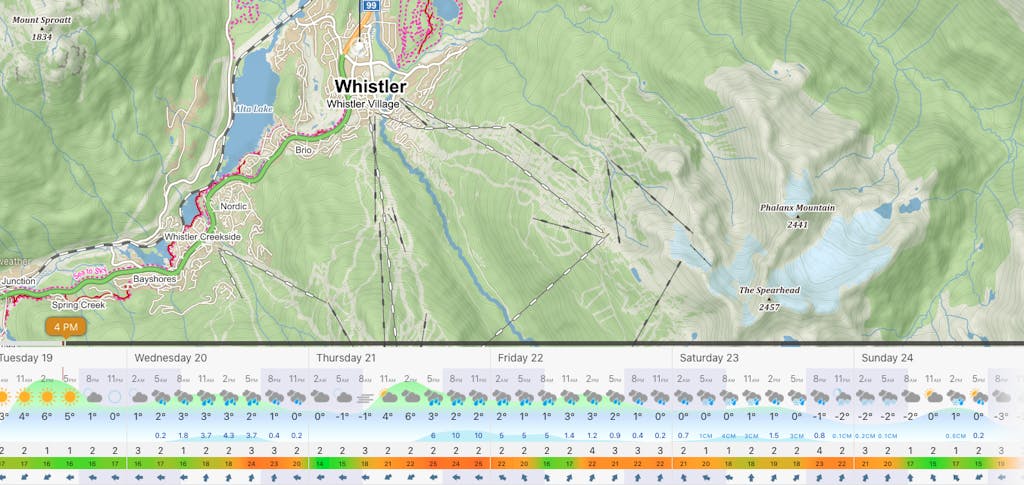
Windy provides layer after layer of weather details for Whistler
Windy App is everything-you-need-to-know-about-weather in a single location. You can dive into the layers for wind speeds/direction, precipitation, refreezing levels and more.
Although it’s not specifically for Whistler ski-conditions, the data is all there. You can use your ski-investigative skills to get truly accurate predictions on the next pop day. Windy allows you to search for Whistler ski conditions, and displays webcams and easy-to-read forecasts.
On the Snow
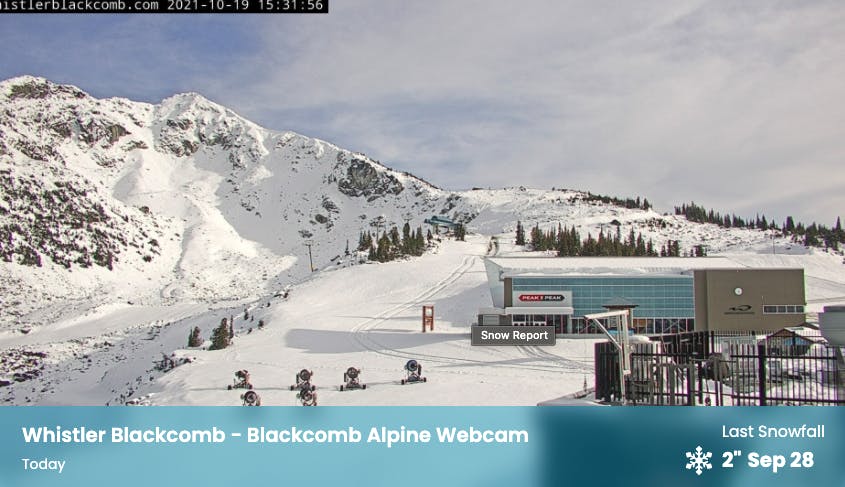
What you see is what you get from the On the Snow.
On the Snow has basic coverage over the whistler snow conditions. The report displays Whistler’s last snowfall, webcams, as well as how many inches of snow are up there. If you don’t care about ice, freezing level, or the snow conditions…. this is the basic info you need.
If Whistler doesn’t look perfect, On the Snow makes it easy to check out other local resorts conditions at the click of a button. On the Snow is great for beginners as it gives a straightforward approach to Whistler ski conditions.
Whistler Blackcomb Official Snow Report
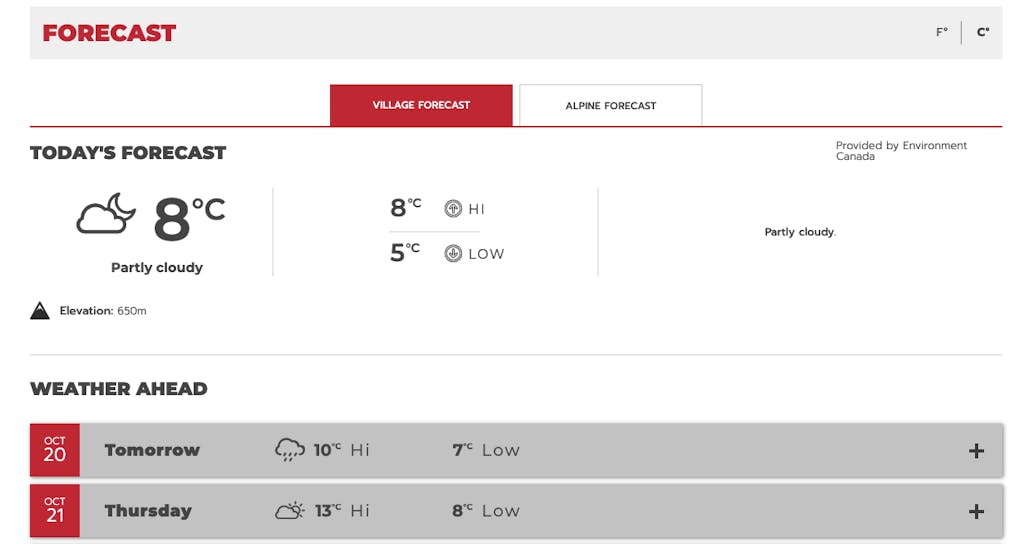
Get it from the source! Whistler’s Official Snow Report
The Whistler Blackcomb Official Snow Report is great for beginners, but lacks in-depth details.
It’s a quick reference for all the essentials, with temperature, accumulation, past information, and future predictions.
The Whistler Blackcomb Official Snow Report has live updates from the four main pit stops on the mountain, as well as webcams. This report is also great for checking which ski lifts are open, and how lines are looking.
Epic Mix Vail Resorts’ Full Coverage Mobile App
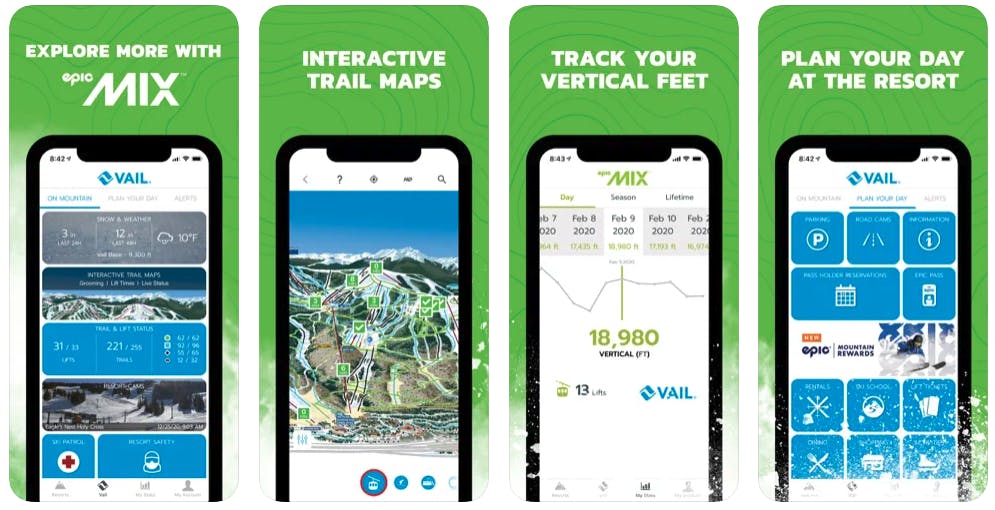
Take the snow report with you, and track your stats with Epic Mix
Epic Mix by Vail Resorts is much like the Whistler Blackcomb Official Snow Report, presumably they are both relying on the same local weather stations to provide the detailed snow report.
It’s a quick and easy spot for all the essentials, with temperature, accumulation, past information, and future predictions, all available on your phone.
Epic Mix is also helpful for more than snow conditions because it includes ski lift information, webcams, and access to ski conditions across different Vail-owned Resorts.
And, if you love the numbers, you can track the vertical feet that you’ve skied over a day, season, or lifetime.
Snow Forecast Ski Conditions
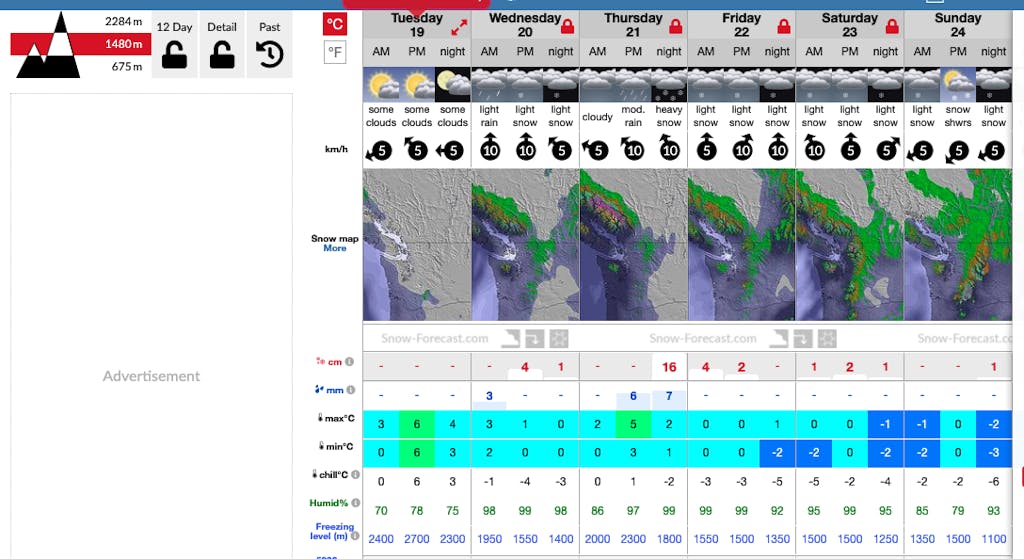
If you surf, this layout from Snow Forecast will look all-too-familiar.
The website is a deep dive into your 6-day forecast covering detailed weather, temperatures, snow fall, wind levels, and freezing levels.The snow forecast will look familiar to anyone who surfs.
Great for anyone wanting to learn more about how to read in-depth snow reports.
Whistler Peak

A basic, but valuable take on the ski condition essentials.
Whistler Peak is a modern forecaster that’s divided into two sections: weather and snow forecasts. You’ll find weather trends, helpful graphs, as well as temperatures, winds, and freezing levels.
Whistler Peak displays basic weather and snow information in an easy-to-read format. If you want the nitty gritty
Wayne Flann Avalanche Blog
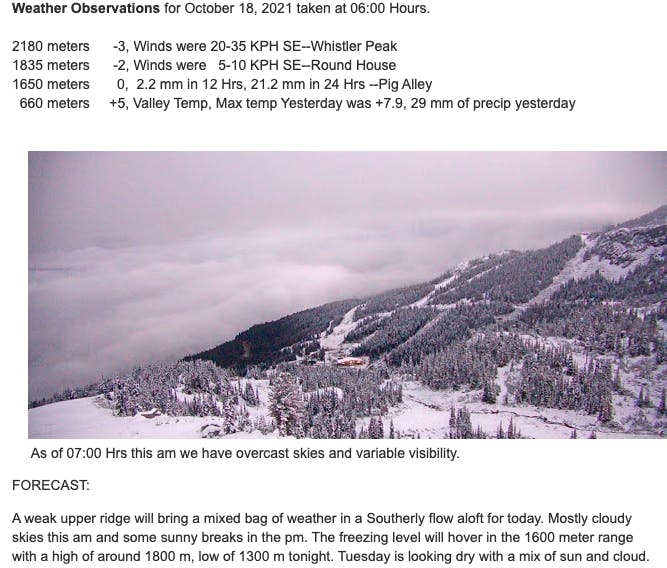
When in doubt, trust the knowledge and predictions of a local — Wayne!
The Wayne Flann Avalanche Blog is great for beginners who want the information in an easy to digest format.
Each day, Wayne shares an in-depth Whistler snow and weather report along with several topography maps, mountain images, and heat maps.
The Wayne Flann Avalanche Blog is perfect for those wanting to know everything there is to know about Whistler ski conditions — from a local expert.
Mountain FM Radio
Mountain FM Radio is perfect for those on the go. Tune in to 102.1 in Whistler and 107.1 in Squamish to hear the Whistler weather and snow conditions told to you as you drive up to the mountain.
Weather reports are shared every 15 minutes between 7 am and 12 pm, and 4 to 7 pm. Between 12 and 4, the reports are every 30 minutes.
1st: Snow Report. 2nd: Shred. 3rd: Apres at Forged.
Hopefully by now you understand how to read a mountain forecast. It’s so important to check the mountain conditions before heading up in order to have the best day possible.
If the Whistler ski conditions aren’t optimal, don’t waste your time and money on a ski day you’ll struggle through. Instead, spend time exploring what’s best in Whistler — including a session at Forged Axe Throwing.
For more apres ideas, check out our blog posts of the best things to do in Whistler.
